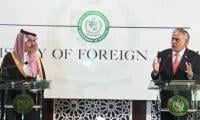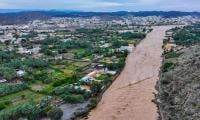ISLAMABAD: Pakistan’s growth is expected to rise in the medium-term, but downside risks include slower growth of workers’ remittances from Middle East because of lower oil prices, a United Nations’ body said on Thursday.
The UN Economic and Social Commission for Asia and the Pacific (UNESCAP), in a survey, said growth is expected to increase further in the near term, to 4.5 percent in 2016 and 4.8 percent in 2017, on the back of continued policy reform efforts, including privatisation of loss-making state-owned enterprises.
Downside risks include slower growth of workers’ remittances, as economies in the Middle East, the major destination of Pakistani migrant workers, continue to face lower oil revenue and subdued economic activity.
Renowned economist Dr Ashfaque Hassan Khan said Pakistan is pursuing an International Monetary Fund's (IMF) dictated ‘stabilisation first’ program for the last several years, which needs to be reversed now. It is necessary to move towards higher growth trajectory for catering two million new job entrants in the market every year, he said.
When asked about the possibility of saying goodbye to the IMF after the expiry of the extended fund facility (EFF) by September 2016, he said Pakistan would have to face the IMF scrutiny under the post program monitoring (PPM). Islamabad utilised more quota under the existing program, so the country became eligible for the PPM. “Almost eight years of austerity measures have suffocated the economy,” he said, adding the need is to promote growth on the IMF outlines given to the euro zone.
The economic growth hovers in the range of three to 3.7 percent per annum. The population was rising slightly above 2.0 percent, so per capita income growth has remained virtually stagnant at less than one percent. “Pakistan has been paying heavy social costs of such policies,” said Dr Ashfaque.
Despite a more favourable economic outlook, Pakistan continues to face significant vulnerabilities from domestic security issues, critical energy shortages and domestic financing of public debt, which constrains the private sector development. These less enabling macroeconomic environments have resulted in a sluggish inflow of foreign direct investment.
Pakistan’s energy demand, as per the report, is expected to exceed domestic supply in the medium term as a result of low investment, distribution challenges, and circular debt flow problems among energy companies. The sector uses only 70 percent of installed capacity, a situation that leads to blackouts lasting for 6-8 hours a day throughout the country.
To address energy shortages, the government introduced new surcharges on power tariffs and inaugurated a solar park in 2015. Pakistan would also benefit from energy transmission from Central Asian countries under the CASA-1000 project going on-steam shortly.
The China-Pakistan Economic Corridor is likely to add 10 gigawatts of power capacity by 2018, the UNESCAP survey states.
As nations begin implementing the 2030 agenda for sustainable development, the next phase of Asia-Pacific economic growth should be driven by broad-based productivity gains, the UNESCAP said.
It emphasised that this would require higher, targeted fiscal spending, enhanced skills, better infrastructure, and improved agricultural productivity.
Launching the survey in Bangkok, Dr Shamshad Akhtar, United Nations Under-Secretary General and ESCAP Executive Secretary, emphasised that steady growth in real wages, which was critical for tackling poverty and inequality, as well as supporting domestic demand, also ultimately depended on productivity growth. —Mehtab Haider
This initiative enables them to earn a dignified livelihood for their families
The event will host more than 700 booths, including leading global and Pakistani tech giants
Gold rates increased by $8 to all-time high rates of $2,371 per ounce in the international market
Strong retail sales prompted economists at Goldman Sachs to boost their gross domestic product
The IMF dictates its terms based on our past performance
Goldman's profit rose 28 percent to $4.13 billion, or $11.58 per share, in the first quarter







